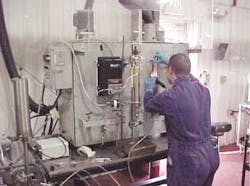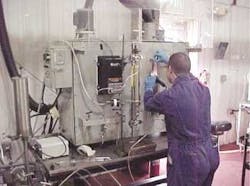Blueprint for a comprehensive reservoir fluids program
A window into the future behavior
William W. "Toddy" Guidry III
Pencor, Division of Core Laboratories
There is a new frontier for some of the world's scientists and engineers, and it is not 1,000 mi into space or deep in some volcano. It is oil and gas explor-ation and development in deepwater environments such as the Gulf of Mexico, offshore Brazil, and off Angola, under thou-sands of feet of water and another 6,000 – 25,000 ft of earth.
Fluid properties have significant impact on field development decisions, which can be multi-billion dollars in scale. Additionally, these decisions are made on the basis of relatively small sample volumes ranging from 250 cc to a maximum of a few gallons. In deepwater environments, sample volumes are limited by the capacity of the available downhole sampling tools. These tools push a probe into the rock formation and suck fluids into attached downhole storage chambers.
Sampling
Onsite fluid sampling and evaluation are critical in offshore considerations. Sample quality must be confirmed before drilling is suspended and samples are shipped back to shore for analysis. Oil-based drilling mud contamination, sand contamination, water emulsions, and sufficient sample volumes are all concerns that need to be answered before sampling is discontinued and the samples are prepared for transport to the lab and analyzed.
Assuming a discovery has been made, the decision to build and deploy a facility exposes an oil company to a huge investment risk. A good understanding of formation fluids plays an essential part in that decision.
The blueprint for a comprehensive fluids program should answer at least three key questions:
- What changes in phase behavior can be expected with expected changes in operating pressures and temperatures
- Whether the fluid has the potential for hydrate formation, asphaltene or wax precipitation, referred to as flow assurance analysis
- The quality, i.e., market price, of the discovered hydrocarbon.
PVT analysis
The first component is the most important and is frequently referred to as reservoir fluid Pressure-Volume-Temperature analysis. PVT analysis is physical simulation of reservoir depletion and associated surface recovery. It allows reservoir engineers to have a window into the future behavior of their respective wells.
PVT laboratories simulate, in a series of three-to-five day experiments, reservoir depletion that will occur over the 10-20-or 30-year life of a field. The most efficient plan for maximum recovery can be developed when a reservoir engineer knows how a reservoir will be-have.
Component analysis
The component analysis is the starting point for any inferences that are made regarding the fluid, in addition the initial input for any type of mathematical modeling is the composition. Most compositional analyses are carried out from methane (C1) to C10, C20, C30, or even C50+.
Asphaltenes represent the heaviest fraction of the oil stream (carbon number 80 and greater) and precipitate when an oil's overall density cannot "support" the extremely dense and heavy asphaltene fraction.
In general, the more extensive the analysis, the better characterized the fluid is and the more robust the initial model will be. Most equation-of-state and simulator models have algorithms that will extend a normalized composition to C50+ or beyond, but providing measured data in this region usually produces more accurate initial models. Reservoir fluid compositions are obtained by flashing the pressurized fluid to atmospheric conditions and them mathematically recombining the measured residual gas and liquid compositions back to initial conditions based on a measured gas to oil ratio recorded during the flash test.
The chemistry of the fluid is critical for determining not only the price the oil will fetch in the market, but also the likelihood of flow assurance problems. Pipeline companies discount the price they pay for crudes for the amount of "impurities" contained in the oil. Oils can be discounted up to $1/bbl per percent sulfur in the dead oil.
Other restrictions include API gravity discounts of up to $0.20/bbl per degree API, both too high and too low, depending on pipeline specifications. In addition, penalties for vapor pressures greater than 10 psi apply in most transport pipelines. Dead oil properties such as acidity, total sulfur content, asphaltene/paraffin content, cloud point, pour point, vapor pressure, and dead oil viscosity at multiple temperatures should be known to aid in the efficient design of facilities.
Testing
Once the initial compositional testing is finished, the depletion and recovery testing begins. PVT labs employ industry-wide techniques to simulate the depletion of black oil, near-critical oil, and gas-condensate reservoirs. These tests investigate the phase behavior of the fluid within expected pressure and temperature ranges.
With black oil reservoirs, this experiment is called the differential liberation or differential vaporization. The gist of this technique revolves around the volumetric measurement of the oil shrinkage and gas evolution as pressure is reduced.
null
The theory behind the experiment comes from the fact that the viscosity difference between the oil and its associated solution gas are vastly different and therefore the phases segregate very readily. They do not remain in contact, and interaction of the two phases is minimal. In the lab, as the gas is liberated upon pressure drop, the two phases separate by isobarically displacing the gas from the PVT vessel.
Properties obtained from this test include gas and oil densities, oil shrinkages, liberated and solution gas volumes, and fluid compressibility data. Viscosity versus pressure data is also measured in conjunction with this testing. Prior to these tests, the bubble point was determined by the intersection of pressure-volume relations in the two-phase and single-phase regions.
This intersection, or discontinuity between to the two slopes, indicates the bubble point of the fluid at a specific temperature. Of course, the importance of the saturation pressure cannot be overstated. The point at which gas evolution begins completely changes the drive dynamics of the reservoir.
Constant volume depletion
For gas-condensate reservoirs, the standard PVT experiment is termed "constant volume depletion." The fluid is held as constant volume while depleting pressure by displacing or "producing" gas from the vessel. Vapor/liquid equilibrium volumes and compositions are measured at several pressures. This data is especially crucial below the dew point.
As a system reaches its dew point, the heavier components in the mix begin to condense or "drop out" in the reservoir. The produced stream becomes leaner and surface yields begin to drop drastically. These changes are monitored and instantaneous and average yields are reported throughout the life of the reservoir in typical gas-condensate PVT reports.
Volatile oil reservoirs
For near-critical or volatile oil reservoirs, a study combining both techniques is used. With lighter oils, the associated solution gas is much heavier or "richer" and the viscosities of the two phases are much closer than typical black oil reservoirs. Therefore, the segregation of the phases, as mentioned earlier, does not happen as quickly as with black oils, and the two phases are held in contact during the experiment.
In addition, the liquid contribution from this rich gas phase is also significant and this "condensate" contribution is also accounted for and reported in volatile oil PVT studies, as compared to black oil calculations, where this condensate is essentially ignored in recovery estimates.
Different equations for reserves estimates are used for these two types of oil reservoirs. Certainly, this portion of a fluids program is the most critical. Having an insight into the phase behavior of the reservoir over time is as critical a piece of knowledge as knowing where to drill in the first place.
A reservoir engineer must be able to model or estimate properties from reservoir temperature to seabed temperatures and from reservoir pressures to 0 psi storage tanks, and the combinations are essentially infinite.
Separator staging
In addition, differing surface configurations can alter yields by as much as 30%. One separator stage versus two? Two versus three? Is a heater needed? Is chemical injection needed? Simulating recovery and behavior of the fluid from the wellbore to its ultimate destination of a tank battery can answer these questions.
Separator staging is simply the act of giving the fluid retention time at some steady state of conditions, allowing the fluid to stabilize for a short period of time. Oil properties such as solution gas-oil ratio and formation volume factor measured during a differential liberation should be "adjusted" through field separator conditions.
Raw data calculated from the PVT experiments does not account for any staging or retention time during the process. Staging minimizes gas evolution, which lowers gas-oil ratios and maximizes liquid recovery, lowering formation volume factors. As mentioned above, using direct differential liberation data, rather than flash corrected data, can yield errors in reserve and recovery calculations up to 30%. Of course, additional facilities mean additional money, and the overall economic impact of such designs needs to be weighed.
In subsea environments, flowline distances, flowline diameters, and valve types and sizes all depend on the chemical and physical properties of the fluid. The effect of 35° F seabed temperatures as well as the effect of commingling several fluid types must be investigated. Preparations need to be made if the results of such influences will, in any way, impede flow of the fluid to its eventual destination.
It is imperative to combine this data with PVT properties, such as when an oil's viscosity limits x amount of wells from reaching its projected quota, the decision may be made where more wells would need to be drilled.
Flow assurance issues
During the life cycle of a typical deepwater project, the majority of the cost comes after the initial exploration phase. The per-well costs are lower, but the sheer number of developmental wells versus exploration wells far outweighs the high costs of deepwater exploration.
By the time this phase is reached, the phase behavior of the fluid must be understood. In addition, it must be known whether certain chemical and physical properties of the fluid will impede flow at different conditions. This knowledge is produced by experiments collectively called flow assurance testing. These types of analyses, as the name implies, determine if such factors as dropping temperatures and pressures will effect the ability of the fluid to flow.
The temperature at which paraffins begin to crystallize is referred to as the "cloud point," or "wax appearance temperature," of the fluid. This value is quite significant, as it indicates the temperature at which solids form in paraffinic crudes and may begin to combine and deposit on the walls of the pipelines, separators, and other vessels. If this process continues, flowlines can actually be blocked, causing flow to stop or slow significantly.
In subsea completions, where flowlines are on the ocean floor at 35° to 40° F, knowledge of wax phase behavior of the crude is critical. The cost of designing and implementing additional flow assurance equipment is substantial, $1-5 million if setup initially. The cost of having to solve such problems where an insufficient program was initially setup, however, can be catastrophic, greater than $10 million alone for adding one additional umbilical line, for example. Prevention is always better than remediation.
Almost assuredly, at subsea temperatures less than 40° F, all wells will need to address paraffin issues. Benchmark tests such as cloud point, pour point and paraffin content can be valuable indicators of wax problems.
Solids precipitation from asphaltenes can also be encountered, although much less common than wax precipitation. Asphaltenes represent the heaviest fraction of the oil stream (carbon number 80 and greater) and precipitate when oil's overall density cannot "support" the extremely dense and heavy asphaltene fraction.
Depletion of undersaturated oil reservoirs increases the density difference between the asphaltene fraction and the overall density of the fluid, thus increasing the likelihood of asphaltene precipitation. Density changes can also be encountered when two zones are commingled for production. Typically, asphaltene problems are encountered in reservoirs that are highly undersaturated (> 3,000 psi) and have relatively light densities (>35° API), with probabilities increasing, as both indicators get higher.
Predicting tools
Last, the evolution of mathematical models and computing technology has provided a tool that was basically unavailable until recent years. PVT experiments performed at multiple scenarios, i.e., pressures, temperatures, and compositions, are used to "tune" these models to essentially predict phase behavior and rheological behavior at virtually any combination of pressure and temperature conditions that may be encountered from cradle to grave.
Reservoir simulators are now capable of predicting the behavior of a reservoir from exploration to depletion 20 years later in a matter of hours. In general, the more measured fluid data available, the more robust the model, which may lead to a higher likelihood that fewer developmental wells need to be drilled, conserving costs.
What price will the oil fetch in the market? How will the fluid behave in the pressure and temperature operating ranges expected? Will the fluid's ability to flow be impeded by certain uncontrollable factors within that same operating range? These questions can all be answered by the chemical and physical properties of a fluid measured in PVT studies, giving the engineer the ammunition needed to make multi-billion dollar decisions and efficiently maximize the return on this investment for the next 20-30 years.



